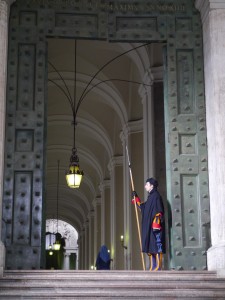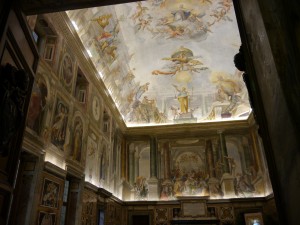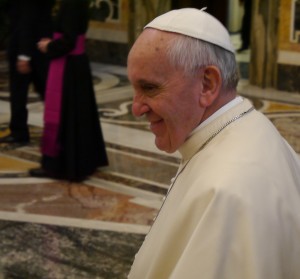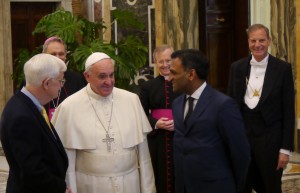An Unexpected Audience with Pope Francis
A routine academic conference turns into an experience of a lifetime
by Chad M. Bauman, Associate Professor of Religion, College of Liberal Arts and Sciences
There appeared to be nothing unusual about the Christianity and Freedom Conference , except, perhaps, that it was located in Rome, in the shadow of the prodigious walls that encompass Vatican City. I’ll admit that as I prepared to attend the conference, I had humored myself by imagining that my visit there might lead to a chance encounter with the new Pope, who had already, in his short papacy, developed a reputation for slipping his security detail, abandoning the security of the papal limousine, going out into the streets, kissing babies, and exchanging skull caps with tourists. But neither I nor those who organized and participated in the conference knew what awaited us in Rome.
The conference was sponsored by the Religious Freedom Project at the Berkley Center for Religion, Peace & World Affairs at Georgetown University. One of the project’s aims is to bring attention to what appears to be a growing number of situations around the world where the freedoms of religious people are circumscribed. Though the project is concerned with the freedoms of all religious people, this particular event focused on Christianity, its contribution to the development of ideas about secularism and democratic liberty in the West, and situations in which Christians are jailed, harassed, attacked, or otherwise under pressure because of their faith or their affiliation with Christianity. I was there to talk about my research on Hindu-Christian conflict in India.
The conference was held at the Pontifical Urbaniana University, and high Catholic officials participated—Archbishop Dominique Mamberti, the Vatican’s Secretary for Relations with States, gave the opening address. Through these connections or some other fortunate circumstance, the conference came to attention of the Pope. Not surprisingly, perhaps, given the topic of the conference, given the fact that the Vatican represents about half of all Christians worldwide, and given that this particular Pope appears intent on improving interfaith relations, Vatican officials began to show some interest in the event. And so, midway through the first day of the two-day conference, conference organizers announced that conference participants had been granted a private audience with Pope Francis.

The next morning, grateful I had packed a suit and tie to wear, I joined the other conference participants in a walk from our hotel to the Vatican. After going through the regular security, we were led past the colorful and venerable Swiss Guards, up several flights of beautifully-wrought stairs, into the papal residence, and finally to the capacious Sala Clementina, which glows dimly with the reflected light of stunning frescos by Renaissance artists Paul Bril, Cherubino and Giovanni Alberti, and Baldassare Croce.

After we waited for a few minutes, Pope Francis arrived. He was greeted by Thomas Farr, Director of the Religious Freedom Project, and then exchanged glances, gestures, and a few short words with the rest of the group. He was smiling and joking almost the entire time, and his tendency to throw his head back in laughter, combined with the low light of the room, resulted in his image appearing blurred in most of my pictures. He posed for some photographs with the group, interacted with us a bit more, and then left the room. This pope is most comfortable speaking in Spanish and Italian, and the only thing he said in English the entire time was “Pray for me,” the phrase he most regularly uses in greeting.

I am not Catholic, but of all the popes who have served during my lifetime, it is this one who most inspires me, and who, it seems to me, shows the most potential for effecting positive change in the world. He has already developed an admirable reputation for simplicity, demonstrated the ability, with humility, to connect with the laity and even non-Catholics, and exhibited a sincere concern for the poor. The entire audience lasted only a few minutes, but even in that short encounter, many of the reasons why he has generated so much enthusiasm and hope, among both Catholics and non-Catholic observers, were readily apparent, and I am sincerely grateful to have had the opportunity to meet him.
